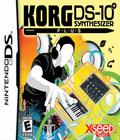Over a year ago, I reviewed a little game called Korg DS-10 Synthesizer. I'd been on a streak of software toys posing as games and wondered how to rate them as games. Here we are again, and it's time to ask the same question, only with Korg DS-10 Synthesizer Plus. It's the same as the original but has improved in various small and large ways, the biggest of which is specific to the DSi. It's also one of the best uses of the biggest DSi feature that Nintendo hasn't advertised. Not to put too big of a point on it, but the results are pretty awesome for those who want the ability to synth things on the go, and it's a worthy enhancement for a specific portion of the interested audience.
The Korg DS-10 software is a fairly precise emulation of the Korg MS-10 Synthesizer, providing you two synths, four drum pads, and enough sliders and knobs to produce many different sound effects. Put together with recording, piano-roll editing, and a full patch-cable board, and you get all the synthesizing power you'd ever need out of the DS, given the limits of the speakers and headphones.
Developer AQ Interactive saw the DSi, with its shinier and less tinny speakers, and decided to redo the program to take advantage of the upgrade. With the software's existing power and potential, they would have a hard time topping the original ... until they noticed that the DSi has twice the processing power of the original DS. They threw in DSi-exclusive support for running two linked MS-10s, with a distinct and complete set of knobs, drums, patch boards, and editors. Additionally, a few editors are recoded to operate both at once, when it's convenient and doesn't get in the way. They also threw in some other feature upgrades that are really useful for working two synths at once, such as being able to edit things during playback in the song mode, per-track mute and solo functionality, and some expansion of the synthesizer's sequencer modes. Ultimately, these features are likely to be overlooked; it took me a fair bit of online searching to realize what was new, aside from the second-synth mode.
Just like before, Korg DS-10 Plus is summed up as "unbridled potential." There's so much to do and absolutely no game-like structures to get in the way. Unfortunately, this extends to the lack of an in-game tutorial, and the manual's pretty technical. It's an incredible 59 pages (longer and slightly denser than before). The tools for creating pretty thorough techno works are fully there, and one could easily see the game being used, as-is, as a real instrument — especially since its interface is a lot quicker to work with than PC simulations, taking fullest advantage of the DS' touch-screen. However, figuring out how to really make it sing remains an immense challenge that will be beyond most people. It's easy to use the default settings to create a few good sounds, but getting at the synth's power is a mess, especially with options that only significantly shift the sound when other effects are in place.
This time around, I managed to get a lot further than before and had some decent basic songs thrown together, entirely within the synthesizer, in a couple of hours. Once again, what startled me most about the software was its potential — and how easy it is to get lost within it. I found myself trying to figure out how I created a particular sound effect, and I'd often end up just going back to the KAOSS Pad and screwing around. It's safe to say that most users are likely to get lost, and the new features don't make the software much easier to use.
Just like before, the graphics are nothing special. Simple 2-D representations of the real synth boards form the exact same clean, dark-colored interface as before, free of visualizations of any sort. The only game-like mode is the ability to connect with other Korg DS-10 Plus users (sorry, no backward compatibility) to jam in a group. This seems like a game that could easily support single-card play, but sadly, no dice. It doesn't really matter much, though, as graphics and multiplayer aren't the point of the title.
Start with nothing, and make everything: You've been handed it again with Korg DS-10 Plus, with a slightly wider definition of "everything." The game could still use a decent tutorial, expansions to the link modes (an official computer-link mode would be especially nice), and some use of the microphone (sampling keyboard mode, anyone?). For those who are looking for something that isn't a game and either know how to work a synth or are willing to spend some serious time learning it, Korg DS-10 Synthesizer remains one of the most interesting programs on the DS system, and Plus is improved enough that first-time buyers should go directly for it. If you're already getting most of the power out of the original and own a DSi, then you should upgrade to Plus.
Score: 8.5/10
More articles about Korg DS-10 Plus











 Designed after the famous KORG MS-10 music synthesizer, KORG DS-10 is a music-creation program for professional and aspiring musicians alike. KORG DS-10 Plus builds on the success of the original, with new upgrades and improved performance that best utilize the high-performance specifications of the DSi.
Designed after the famous KORG MS-10 music synthesizer, KORG DS-10 is a music-creation program for professional and aspiring musicians alike. KORG DS-10 Plus builds on the success of the original, with new upgrades and improved performance that best utilize the high-performance specifications of the DSi.